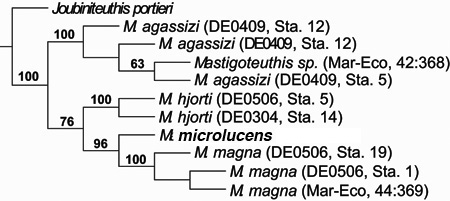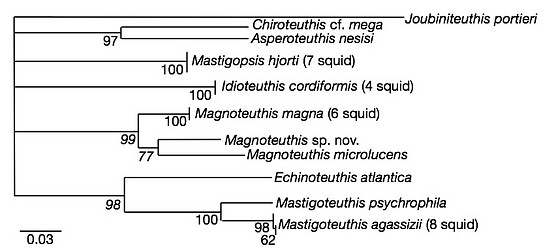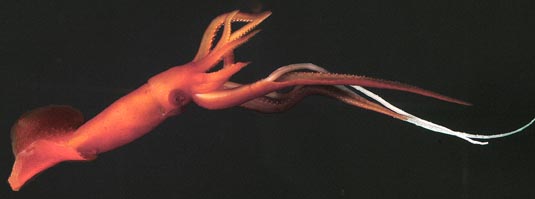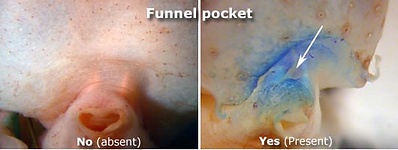Mastigoteuthidae
Michael Vecchione, Richard E. Young, and Annie Lindgren- Mastigoteuthis Verrill, 1881
- Idioteuthis Sasaki, 1916
- Echinoteuthis Joubin, 1933
- Mastigopsis hjorti (Chun, 1913)
- Magnoteuthis Salcedo-Vargas & Okutani 1994
- Mastigotragus Young, Vecchione & Baird 2014
Introduction
Mastigoteuthids are deep water pelagic or benthopelagic squids that are morphologically distinctive. They are weakly muscled, reddish in color and have elongate fourth arms and whip-like tentacular clubs. Much of the red pigment is not in chromatophore organs but dispersed in other integumental cells, although chromatophores are present. The Mastigoteuthidae, however, is among the most taxonomically confused families of all deep-sea squid due to the fact that many characters are based on the structures (tentacles and skin photophores) often lost during capture.
The whip-like tentacles have tentacular clubs that are little differentiated from the tentacular stalks eventhough they are covered with thousands of minute suckers. In some species, the suckers are so small as to be invisible to the naked eye. The photograph below shows the midregion of a tentacular club with the sucker-bearing portion marked by an X. The arrow points to a microscope enlargment showing the small suckers. Such small suckers, at least in freshly dead specimens, seem to function much like "fly paper" in that anything touching them, whether large or small, sticks.

Figure. Side view of a portion of the tentacle club (bottom) of Magnoteuthis microlucens, Hawaiian waters, showing the club covering the top half of the cyclindrical tentacle. Insert - Portion of the club, marked by an "X", as seen through a microscope. Photographs by R. Young.
Histological sections through the tentacle can be seen here.
Fins are usually very large and positioned mostly posterior to the muscular part of the mantle. No well-developed system of giant nerve fibers is present, which reflects the absence of rapid jet propulsion (Dilly, et al., 1977).
Brief diagnosis:
Member of the chiroteuthid families ...- with arms IV longest.
- with cyclindrical, whip-like tentacular clubs bearing small suckers in numerous irregular series.
- with oval funnel locking-apparatus usually bearing various knobs or lobes (tragus and antitragus) affecting the shape of the groove.
Characteristics
- Arms
- Arms IV longest, thickest and with expanded lateral membranes which form tentacular sheaths which can envelope entire contracted tentacles.
- Tentacles
- Tentacular clubs elongate, virtually cylindrical; with suckers in many irregular series (30 or more in some species).
- Head.
- Funnel
- Funnel locking-apparatus oval, usually with knobs (tragus, antitragus) affecting the shape of the depression in the funnel component that often varies between species.
- Fins
- Fins large (ca. 50% of ML) to very large (ca. 90% of ML).
- Fins with terminal position.
- Tail
- Short tail present (often absent due to damage during capture).
- Tail supported by secondary conus.
- Photophores
- Photophores present on eyeball or eyelid and/or integument or absent.
Comments
Species and genera in the Mastigoteuthidae
- Mastigoteuthis: M. agassizii (Atlantic Ocean), M. dentata (IndoPacific Oceans), M. psychrophila (Antarctic and adjacent waters).
- Idioteuthis: I. cordiformis (Western Pacific).
- Echinoteuthis: E. atlantica and E. danae (Atlantic Ocean), E. famelica (Central Pacific), E. glaukopis and E. tyroi (Indian Ocean).
- Mastigopsis: Mp. hjorti (circumglobal).
- Magnoteuthis: Mg. magna (Atlantic), Mg. microlucens (tropical Pacific), Mg. type beta (subantarctic Pacific).
- Mastigotragus: Mt. pyrodes (North Pacific).
The following table compares species/species-groups.
| Funnel pocket* | Funnel locking- apparatus* | Integumental photophores* | Eyeball photo- phores | Eyelid photo- phores* | Chromato- phores** | Tubercules in subadults | |
| Mastigoteuthis | Yes | Ear shaped | Yes | No | Tiny | Scattered | No |
| Idioteuthis | No | Ear shaped | No | No | No | Abundant | Yes |
| Echinoteuthis | Yes | Ear shaped | No | No | Large | Abundant | No |
| Mastigopsis | No | Oval | No | Yes | No | Abundant | Yes |
| Magnoteuthis | No | Flask shaped | No / microscopic | No | No | Abundant/absent? | No |
| Mastigotragus | Yes | Ear shaped but no antitragus | Yes | No | Medium | Abundant | No |
*Funnel pocket (arrow) extends between funnel bridles deep into the head to the cephalic vein. Presence of the pocket can be recognized in the paralarval stage onward (at least in M. famelica).
*Funnel locking-apparatuses have three major forms.
*Integumental photophores are of three types. Those of Mastigoteuthis (below left) and M. pyrodes (below middle) look superficially the same. Those of Magnoteuthis microlucens (below right) are much smaller and very difficult to see (in the photograph they are apparent since most of the covering chromatophore-bearing skin has been lost during capture.
*Eyelid photophores (arrows) occur in three sizes. Compare Small and Medium sizes with the size of the nearby integumental photophores. Species with Large eyelid photophores lack integumental photophores.
**Chromatophores. See photographs of integumental photophores above. Count the number of chromatophores between photophores in Mastigoteuthis and in M. pyrodes to see the difference between "scattered" and "abundant" chromatophores. See the Mastigoteuthis page to compare the integument of these two genera.
Discussion of Phylogenetic Relationships
The genera in the family are all distinct. The relationships between genera are not clear. M. pyrodes may be closest to Mastigoteuthis and Echinoteuthis as they all share a funnel pocket (this feature, however, is probably a pleisiomorphy) and an eyelid photophore. The presence of integumental photophores over much of the ventral surfaces may indicate closer relationship to Mastigoteuthis, but the structure of the photophores has not been examined in M. pyrodes, and they superficially appear to be different from those of Mastigoteuthis spp. Species in all the above genera share long, slender clubs with sucker orifices dominated by pegs on the outer ring and not teeth on the inner ring. Idioteuthis cordiformis and Mastigopsis hjorti show many similarities (absence of funnel pocket and skin photophores, relatively short tentacular clubs with large suckers whose orifices are dominated by teeth on the inner rings, large fins, virtually identical skin tubercules and probably have a common ancestor. Species Magnoteuthis have uncertain relationships based on morphology. They are similar to M. cordiformis and M. hjorti in the absence of a funnel pocket but have tentacles more similar to the other species in the other genera.
Two studies have used molecular data to determine relationships in the family. The first study was based on three genes from ten individuals in four species and used a related species, Joubiniteuthis portieri, as the outgroup. This study yielded the single tree (L= 515, CI= 89, RI= 90) (Young et al., 2008) seen below. These limited data suggested that M. hjorti may be the closest relative of the M. magna-group.


Figure. Phylogenetic analysis of the combined data (COI, 16S, 12S). Numbers in bold above branches indicate jackknife support values above 50%. Phylogenetic tree from Young, et al. (2008). Details on the squid that provided the molecular data can be found here.


Figure. Maximum-likelihood consensus tree based on a partitioned analysis (COI, 12S rRNA, 16S rRNA). Numbers at nodes are support value sabove 50%. Phylogenetic tree modified from Braid, et al., 2013.
A Bayesian maximum clade credibility tree indicated relationship between E. atlantica and Mastigoteuthis species with posterior probability of 100 and relationship between Mastigopsis hjorti and Magnoteuthis spp. with posterior probability of 76. I. cordiformis did not group with either of these clades but came off the tree in a basal position. The authors question the position of I. cordiformis within the family. Lindgren (2010) in broader phylogenetic studies of the Oegopsida and Lindgren et al., (2012) of the Cephalopoda (2012) found that the mastigoteuthids examined did not form a natural group. While the genera presently recognized within the family are very distinct, the family may not be.
Nomenclature
In previous versions of this page, all species were placed in a single genus Mastigoteuthis and within this genus they were placed into species groups. Recently, the family has been reviewed based on both morphology and a strong input from molecular analysis (Heather et al., (2013). They reviewed earlier classifications and verified the species groups previously used here but their DNA analysis was sufficiently robust (see section on "Discussion of Phylogenetic Relationships" above) to warrant placing these groups in genera, which they did. Their terminology has been adopted here.A list of all nominal genera and species in the Mastigoteuthidae can be found here. The list includes the current status and type species of all genera, and the current status, type repository and type locality of all species and all pertinent references.
Species of doubtful validity or uncertain status are described here. These species are: Idioteuthis latipinna, Mastigoteuthis islini, Magnoteuthis inermis, Mastigoteuthis okutanii and Chiroteuthoides hastula.
Behavior
Two species (Mastigopsis hjorti, Magnoteuthis magna) have been observed from submersibles drifting just above the ocean floor with tentacles dangling within a few mm of the bottom, presumably, to capture copepods and other small plankters of the epibenthic zooplankton (Roper and Vecchione, 1997). The tentacles extend from the tips of the ventral arms (arms IV) from where they reside in the tentacular sheaths (i. e., between the arms and their lateral membranes). The tentacles are typically held apart by the ventral arms (the "tuning fork" posture) so they "fish" independently of each other (Roper and Vecchione, 1997).


Figure. Left top - Side view of the head and brachial crown of M. agassizii. Arrow points to the tentacle base neatly enveloped by the lateral membrane of arm IV. Photograph by David Shale. Right top - Ventrolateral view of Magnoteuthis magna drifting just above the ocean floor with fins folded and tentacles extending from arms IV, ROV photograph. The arrow points to the place where the tentacle emerges from the tentacular sheath of the right arm IV. Photograph provided by NOAA's Ocean Exploration program. Bottom - Dorsal view of a portion of a ventral arm (arm IV) of M. agassizii with the tentacle (white) mostly hidden within the tentacular sheath. The entire length of the tentacle apparently can be held within the tentacular sheath. Photograph by David Shale. Views of M. agassizii were photographed in a shipboard aquarium by David Shale on an NSF cruise with Marsh Youngbluth, Harbor Branch Oceanographic Institution, N.E. Atlantic waters. The brilliant red color in both images has been reduced in Photoshop to accentuate detail. ©
References
Braid, H. E., P. D. McBride, K. S. R. bolstad. 2014. Molecular phylogenetic analysis of the squid family Mastigoteuthidae (Mollusca, Cephalopoda) based on three mitochondrial genes. Hydrobiologia, 725 (1): 145-164.
Dilly, P. N., M. Nixon and J. Z. Young. 1977. Mastigoteuthis--the whip-lash squid. J. Zool., Lond., 181: 527-559.
Lindgren, A. R., 2010. Molecular inference of phylogenetic relationships among Decapodiformes (Mollusca: Cephalopoda) with special focus on the squid Order Oegopsida. Molecular Phylogenetics and Evolution 56: 77–90.
Lindgren, A. R., M. S. Pankey, F. G. Hochberg and T. H. Oakley. 2012. A multi-gene phylogeny of Cephalopoda supports convergent morphological evolution in association with multiple habitat shifts in the marine environment. BMC Evolutionary Biology 2012, 12:1. doi:10.1186/1471-2148-12-129.
Nesis, K.N. 1977. Mastigoteuthis psychrophila sp. n. (Cephalopoda, Mastigoteuthidae) from the Southern Ocean. Zoologichesky Zhurnal, 65(6):835-842.
Roper, C. F. E. and M. Vecchione, 1997. In-situ observations test hypotheses of functional morphology in Mastigoteuthis (Cephalopoda, Oegopsida). Vie Milieu 47:87-93.
Salcedo-Vargas, M. A. and T. Okutani. 1994. New classification of the squid family Mastigoteuthidae (Cephalopoda: Oegopsida). Venus 53: 119-127.
Salcedo-Vargas, M. A. 1997. Cephalopods from the Netherlands Indian Ocean Programme (NIOP) - II. Mastigoteuthid lineage and related forms. Beaufortia, 47: 91-108.
Young, R. E., A. Lindgren and M. Vecchione. 2008. Mastigoteuthis microlucens, a new species of the squid family Mastigoteuthidae (Mollusca: Cephalopoda). Proc. Biol. Soc. Wash. 121(2): 276-282.
Young, R. E., M. Vecchione and D. Donovan. 1999. The evolution of coleoid cephalopods and their present biodiversity and ecology. South African Jour. Mar. Sci., 20: 393-420.
Title Illustrations

About This Page

National Museum of Natural History, Washington, D. C. , USA

University of Hawaii, Honolulu, HI, USA

Ohio State University, Columbus, Ohio, USA
Page copyright © 2019 , , and
 Page: Tree of Life
Mastigoteuthidae .
Authored by
Michael Vecchione, Richard E. Young, and Annie Lindgren.
The TEXT of this page is licensed under the
Creative Commons Attribution-NonCommercial License - Version 3.0. Note that images and other media
featured on this page are each governed by their own license, and they may or may not be available
for reuse. Click on an image or a media link to access the media data window, which provides the
relevant licensing information. For the general terms and conditions of ToL material reuse and
redistribution, please see the Tree of Life Copyright
Policies.
Page: Tree of Life
Mastigoteuthidae .
Authored by
Michael Vecchione, Richard E. Young, and Annie Lindgren.
The TEXT of this page is licensed under the
Creative Commons Attribution-NonCommercial License - Version 3.0. Note that images and other media
featured on this page are each governed by their own license, and they may or may not be available
for reuse. Click on an image or a media link to access the media data window, which provides the
relevant licensing information. For the general terms and conditions of ToL material reuse and
redistribution, please see the Tree of Life Copyright
Policies.
- Content changed 26 March 2019
Citing this page:
Vecchione, Michael, Richard E. Young, and Annie Lindgren. 2019. Mastigoteuthidae . Version 26 March 2019 (under construction). http://tolweb.org/Mastigoteuthidae/19453/2019.03.26 in The Tree of Life Web Project, http://tolweb.org/












 Go to quick links
Go to quick search
Go to navigation for this section of the ToL site
Go to detailed links for the ToL site
Go to quick links
Go to quick search
Go to navigation for this section of the ToL site
Go to detailed links for the ToL site